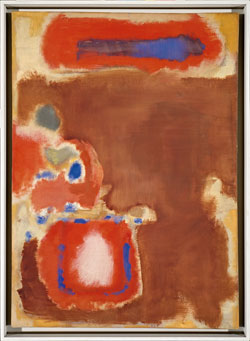1.4
Middle Years Activity
Wet into Wet: Exploration of Pigments and Supports

Mark ROTHKO
Russian/American 1903–70
Untitled 1947
oil on canvas
121.0 x 90.1 cm
Solomon R. Guggenheim Museum, New York
Gift, The Mark Rothko Foundation, Inc.
© Mark Rothko/ARS, New York. Licensed by VISCOPY Australia
83.3420
For |
Middle Years Students |
Curriculum |
Visual Arts – Creating and Making |
Think About |
"I think of my pictures as dramas; the shapes in the pictures are the performers. They have been created from the need for a group of actors who are able to move dramatically without embarrassment and execute gestures without shame." Mark Rothko tried to express human emotion and spiritual experience with broad areas of intense, sometimes clashing colour, which appear to hover on the surface of the canvas. |
Aim |
To research Mark Rothko and complete a practical activity. |
Preparation |
To do this activity you will need to:
Possible materials:
|
Individual Task |
Discuss and explain the different moods and feelings that are conveyed with each of the different compositions. |
Research Questions |
Read more about the way Rothko uses shape and colour to communicate emotion. |
Group Task |
Discuss your response to this work with others. |
Discussion Questions |
Chris McAuliffe, director of Ian Potter Museum of Art said Rothko's work: "probably embodies what a lot of people think abstract art is about-kind of ethereal, lyrical, abstract and luscious". Describe the characteristics of Rothko's composition, particularly his divisions of colours on the canvas. |